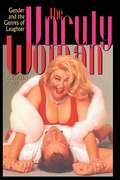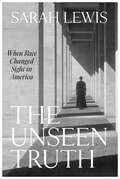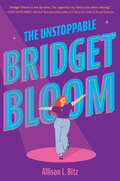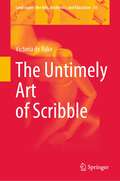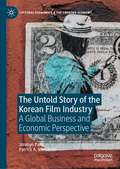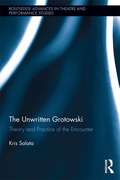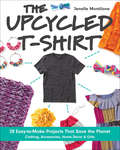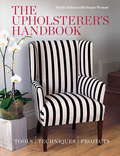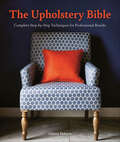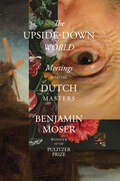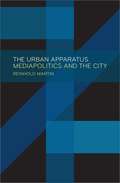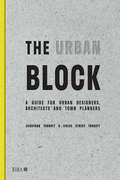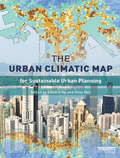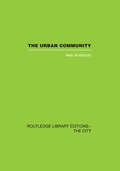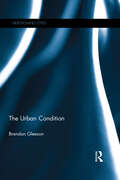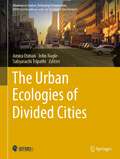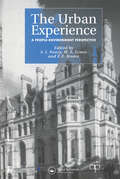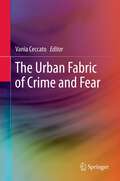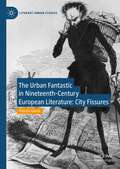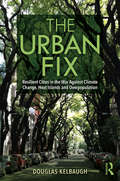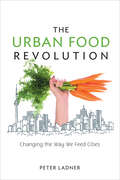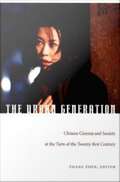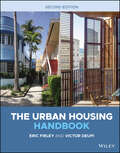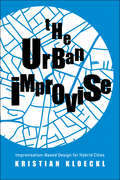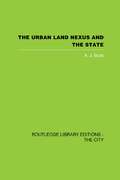- Table View
- List View
The Unruly Woman
by Kathleen RoweUnruly women have been making a spectacle of themselves in film and on television from Mae West to Roseanne Arnold. In this groundbreaking work, Kathleen Rowe explores how the unruly woman-often a voluptuous, noisy, joke-making rebel or "woman on top"-uses humor and excess to undermine patriarchal norms and authority. At the heart of the book are detailed analyses of two highly successful unruly women-the comedian Roseanne Arnold and the Muppet Miss Piggy. Putting these two figures in a deeper cultural perspective, Rowe also examines the evolution of romantic film comedy from the classical Hollywood period to the present, showing how the comedic roles of actresses such as Katharine Hepburn, Barbara Stanwyck, and Marilyn Monroe offered an alternative, empowered image of women that differed sharply from the "suffering heroine" portrayed in classical melodramas.
The Unseen Truth: When Race Changed Sight in America
by Sarah LewisThe award-winning art historian and founder of Vision & Justice uncovers a pivotal era in the story of race in the United States when Americans came to ignore the truth about the false foundations of the nation’s racial regime.In a masterpiece of historical detective work, Sarah Lewis exposes one of the most damaging lies in American history. There was a time when Americans were confronted with the fictions shoring up the nation’s racial regime and learned to disregard them. The true significance of this hidden history has gone unseen—until now.The surprising catalyst occurred in the nineteenth century when the Caucasian War—the fight for independence in the Caucasus that coincided with the end of the US Civil War—revealed the instability of the entire regime of racial domination. Images of the Caucasus region and peoples captivated the American public but also showed that the place from which we derive “Caucasian” for whiteness was not white at all. Cultural and political figures ranging from P. T. Barnum to Frederick Douglass, W. E. B. Du Bois to Woodrow Wilson recognized these fictions and more, exploiting, unmasking, critiquing, or burying them.To acknowledge the falsehood at the core of racial order proved unthinkable, especially as Jim Crow and segregation took hold. Sight became a form of racial sculpture, vision a knife excising what no longer served the stability of racial hierarchy. That stability was shaped, crucially, by what was left out, what we have been conditioned not to see. Groundbreaking and profoundly resonant, The Unseen Truth shows how visual tactics have long secured our regime of racial hierarchy in spite of its false foundations—and offers a way to begin to dismantle it.
The Unstoppable Bridget Bloom
by Allison L. BitzA bright and fun fat-positive YA novel about learning how to express yourself when what has always defined you is no longer an option. Perfect for fans of Julie Murphy and Emma Lord.Bridget Bloom’s out-of-this-world voice is the perfect fit for center stage. When Bridget’s admitted to Richard James Academy, a college prep boarding school with a prestigious music program—where heartthrob Duke Ericson attends—all her dreams are on track to come true: leave the hometown where she’s never belonged, fall in love, and launch her Broadway career.But upon arriving at the academy, she learns that due to her low music theory scores, she’s not eligible to perform or earn the sponsorship she needs to afford the tuition. Worst of all, Dean of Students Octavia Lawless, the one person with the power to reverse the decision, challenges her to work on her humility . . . by not singing at all.Without her voice, Bridget will have to get out of her comfort zone and find a new way to shine. Good thing she is unstoppable!From debut author Allison L. Bitz comes a coming-of-age story of self-discovery, humility, friendship, and love. Includes sheet music for two original songs!
The Untimely Art of Scribble (Landscapes: the Arts, Aesthetics, and Education #34)
by Victoria de RijkeThis book offers new definitions, vocabularies and insights for “scribbling”, viewing it as a fascinating and revealing process shared by many different disciplines and practices. The book provides a fresh and timely perspective on the nature of mark making and the persistence of the gestural impulse from the earliest graphic marks to the most sophisticated artistic production. The typical treatment of scribbling in the literature of artistic development has cast the practice as a prelude to representation in drawing and writing, with only occasional acknowledgment of the continuing joy and experiment of making marks across many arts practices. The continuous line the author traces between the universal practice of scribbling in infancy and early childhood and the work of radical creativity for contemporary and historical artists is original and clarifying, expanding the range of drawing behaviors to that of avant-garde painters, performance and the digital.
The Untold Story of the Korean Film Industry: A Global Business and Economic Perspective (Cultural Economics & the Creative Economy)
by Jimmyn Parc Patrick A. MesserlinThis book analyses the Korean film industry emergence and development in a global business and economic perspective. This is one of the first books to compare the film policies and industries of the world’s six largest film industries – featuring Korea as the central character – with the aim of defining the contours of what constitutes an effective film policy. It presents many cases showing that, contrary to what is often believed, an economically sound policy is a good instrument for achieving desired cultural goals. It uses a set of analytical tools – borrowed from the economic analysis of international trade policies – to provide a rich harvest of new, rigorous, and often unexpected results on the effectiveness of the existing film policies. The implications found in this book are relevant not only for Korea, but for all other countries that wish to foster or enhance the competitiveness of their film industries. This book will be of interest to a wide spectrum of scholars interested in cultural studies – media and cultural specialists, political scientists, sociologists, historians – in addition to business analysts and economists specialized in cultural economics. As this book focuses on film policies and how to improve them, it will also appeal to policymakers, business figures, public relations officials, and staff from international organizations working on the film industry.
The Unwritten Grotowski: Theory and Practice of the Encounter (Routledge Advances in Theatre & Performance Studies)
by Kris SalataThis book gives a new view on the legacy of Jerzy Grotowski (1933-1999), one of the central, and yet misunderstood, figures who shaped 20th-century theatre, focusing on his least known last phase of work on ancient songs and the craft of the performer. Salata posits Grotowski’s work as philosophical practice, and more particularly, as practical research in the phenomenology of being, arguing that Grotowski’s departure from theatrical productions (and thus critical consideration) resulted from his uncompromising pursuit of one central problem, "What does it mean to reveal oneself?" — the very question that drove his stage directing work. The book demonstrates that the answer led him through the path of gradually stripping the theatrical phenomenon down to its most elemental aspect, which shows itself through the craft of the performer as a non-representational event. This particular quality released at the heights of the art of the performer is referred to as aliveness, or true liveness in this study in order to shift scholarly focus onto something that has always fascinated great theatre practitioners, including Stanislavski and Grotowski, and of which academic scholarship has limited grasp. Salata’s theoretical analysis of aliveness reaches out to phenomenology and a broad range of post-structural philosophy and critical theory, through which Grotowski’s project is portrayed as philosophical practice.
The Upcycled T-Shirt: 28 Easy-to-Make Projects That Save the Planet: Clothing, Accessories, Home Decor & Gifts
by Jenelle MontiloneConsume less and create more—by turning old T-shirts into new treasures. Kid-friendly projects included! Did you know the average American throws away more than sixty-eight pounds of clothing each year? Join the revolution to reduce your carbon footprint—one T-shirt at a time! Widely known for her recycling efforts, environmental crafter Jenelle Montilone will show you how to upcycle tees into fun and fanciful quilts, accessories, toys, and gifts for the whole family. With nearly 30 easy-to-make ideas, you&’ll consume less and create more!
The Upholsterer's Handbook
by Nicole Fulton Stuart WestonIn eye-capturing style The Upholsterer's Handbook offers everything you need and more, in order to prepare and inspire you to create beautifully upholstered furniture. The upholstered pieces range in skill level from simple seats to more complex items such as a button-back chair. Various styles of furniture are covered, from classic and elegant to other more styled and designer pieces.The Upholsterer's Handbook opens with sections on sourcing furniture, tools and materials, and choosing fabrics - including finishes and trimmings, which are often the key to the success of a piece. With special photography throughout, basic techniques are illustrated step-by-step, from stripping back to top stuffing to making cushions. 18 stunning projects are featured with varying skill levels, covering such diverse items as a G-plan chair, a sofa, a '70s flower-shaped stool, dining chairs, and headboards. Throughout Nicole Fulton demonstrates techniques using linen, satin, velvet, leather, cowhide, and other fabrics that give the furniture a unique contemporary look.
The Upholstery Bible: Complete Step-by-Step Techniques for Professional Results
by Cherry DobsonA complete course in upholstering furniture, including tooling up, selecting stuffings and outer textiles, techniques, and cutting plans. The Upholstery Bible is a one-stop resource for furniture upholstering, regardless of your abilities, with easy-to-follow, illustrated instructions explaining all the essential upholstery techniques, from covering buttons to stripping and upholstering entire chairs. Build your skills at your own pace, with advice on the basics such as choosing materials and tools for the job and estimating yardage, as well as more complex upholstering techniques. The Upholstery Bible features invaluable advice on what to look for when buying second hand furniture, teaching you what&’s fixable and what&’s not as well as how to avoid costly mistakes by choosing the right stitches, and techniques and textiles for the job. &“Dobson breaks up the technical stuff with a more inspiring approach . . . If you&’re starting out, I&’d say this would be a brilliant resource to have . . . offers plenty of answers to the most common gotchas.&” —Vintique Upholstery
The Upside-Down World: Meetings with the Dutch Masters
by Benjamin MoserPlunged into a strange land at twenty-five, Benjamin Moser began an obsessive, decades-long study of the Dutch Masters to set his world right again. Arriving as a young writer in an ancient Dutch town, Benjamin Moser found himself visiting—casually at first, and then more and more obsessively—the country’s great museums. Inside these old buildings, he discovered the remains of the Dutch Golden Age and began to unearth the strange, inspiring, and terrifying stories of the artists who gave shape to one of the most luminous moments in the history of human creativity. Beyond the sainted Rembrandt—who harbored a startling darkness—and the mysterious Vermeer, whose true subject, it turned out, was lurking in plain sight, Moser got to know a whole galaxy of geniuses: the doomed virtuoso Carel Fabritius, the anguished wunderkind Jan Lievens, the deaf prodigy Hendrik Avercamp. And through their artwork, he got to know their country, too: from the translucent churches of Pieter Saenredam to Paulus Potter’s muddy barnyards, and from Pieter de Hooch’s cozy hearths to Jacob van Ruisdael’s tragic trees. Year after year, as he tried to make a life for himself in the Netherlands, Moser found friends among these centuries-dead artists. And he found that they, too, were struggling with the same questions that he was. Why do we make art? What even is art, anyway—and what is an artist? What does it mean to succeed as an artist, and what does it mean to fail? Is art a consolation—or a mortal danger? The Upside-Down World is an invitation to ask these questions, and to turn them on their heads: to look, and then to look again. This is Holland and its great artists as we’ve never seen them before. And it’s a sumptuously illustrated, highly personal coming-of-age-story, twenty years in the making: a revealing self-portrait by one of the most acclaimed writers of his generation.
The Urban Apparatus: Mediapolitics and the City
by Reinhold MartinUrbanization is a system of power and knowledge, and today&’s city functions through the expansive material infrastructures of the urban order. In The Urban Apparatus, Reinhold Martin analyzes urbanization and the contemporary city in aesthetic, socioeconomic, and mediapolitical terms. He argues that understanding the city as infrastructure reveals urbanization to be a way of imparting functional, aesthetic, and cognitive order to a contradictory, doubly bound neoliberal regime.Blending critical philosophy, political theory, and media theory, The Urban Apparatus explores how the aesthetics of cities and their political economies overlap. In a series of ten essays, with a detailed theoretical introduction, Martin explores questions related to urban life, drawn from a wide range of global topics—from the fiscal crisis in Detroit to speculative development in Mumbai to the landscape of Mars, from discussions of race and the environment to housing and economic inequality. Each essay proposes a particular &“mediator&” (or a material complex) that is shaped by imaginative practices, each answering the question &“What is a city, today?&” The Urban Apparatus serves as an &“urban&” bookend to the architectural questions explored by Martin in his earlier book Utopia&’s Ghost, and ultimately offers readers a way to think politically about urbanization.
The Urban Block: A Guide for Urban Designers, Architects and Town Planners
by Jonathan Tarbatt Chloe Street TarbattThe block is no more than the land and building area defined by streets. It is the nature of the interface between the two, which has a critical impact on the quality of the spaces between those buildings. The importance of the block to city life is well rehearsed, and in any case, we seldom find ourselves in the business of making cities from scratch. But we are in the business of making new houses, neighbourhoods and new local centres, and we need lots of them: 250,000 a year to be imprecise. Against the background of a burgeoning housing shortage in the UK, there are varied issues to be reconciled. The Urban Block charts the fall and rise of the perimeter block as the staple of urban form and structure from ancient times. It takes you through the process of understanding, defining, structuring and designing the block. Carefully selected urban and suburban case examples explain “do's and don'ts” of good block layout and will help you to produce better masterplans, while staying in touch with commercial realities.
The Urban Climatic Map: A Methodology for Sustainable Urban Planning
by Edward Ng Chao RenRapid urbanization, higher density and more compact cities have brought about a new science of urban climatology. An understanding of the mapping of this phenomenon is crucial for urban planners. The book brings together experts in the field of Urban Climatic Mapping to provide the state of the art understanding on how urban climatic knowledge can be made available and utilized by urban planners. The book contains the technology, methodology, and various focuses and approaches of urban climatic map making. It illustrates this understanding with examples and case studies from around the world, and it explains how urban climatic information can be analysed, interpreted and applied in urban planning. The book attempts to bridge the gap between the science of urban climatology and the practice of urban planning. It provides a useful one-stop reference for postgraduates, academics and urban climatologists wishing to better understand the needs for urban climatic knowledge in city planning; and urban planners and policy makers interested in applying the knowledge to design future sustainable cities and quality urban spaces.
The Urban Condition (Questioning Cities)
by Brendan GleesonThis book will speak to the new human epoch, the Urban Age. A majority of humanity now lives for the first time in cities. The city, the highest invention of the modern age, is now the human heartland. And yet the same process that brought us the city and its wonders, modernisation, has also thrown up challenges and threats, especially climate change, resource depletion, social division and economic insecurity. This book considers how these threats are encountered and countered in the urban age, focusing on the issue of human knowledge and self-awareness, just as Hannah Arendt’s influential The Human Condition did half a century ago. The Human Condition is now The Urban Condition. And it is this condition that will define human prospects in an age of default and risk. Gleeson expertly explores the concept through three main themes. The first is an exploration of what defines the current human condition, especially the expanding cities that are at the heart of an over-consumptive world economic order. The second exposes and reviews the reawakening of forms of knowledge (‘naturalism’) that are likely to worsen not improve our comprehension of the crisis. The new ‘science of urbanism’ in popular new literature exemplifies this dangerous trend. The third and last part of the book considers prospects for a new urban, and therefore human, dispensation, ‘The Good City’. We must first journey in our urban vessels through troubled times. But can we now start to plot the way to new shores, to a safer, more resilient city that provides for human flourishing? The Urban Condition attempts this ideal, conceiving a new urbanism based on the old idea of self-limitation. The Urban Condition is an original, timely book that reconsiders and redeploys Arendt’s famous notion of The Human Condition in an age of cities and risk. It brings together several important strands of human consideration, urbanisation, climate threat, resource depletion, economic default and critical knowledge and weaves them into a new analysis of the times. It also looks to a future that is nearly with us—of changed climate, resource scarcity and economic stress. The book journeys into these troubled times, proposing the idea of Lifeboat Cities as a way of thinking about the human journey to come
The Urban Ecologies of Divided Cities (Advances in Science, Technology & Innovation)
by John Nagle Amira Osman Sabyasachi TripathiThe book discusses how division affect the fabric of cities, and people’s sense of identity and agency, and are reflected in physical features, architecture, and urban planning. The question of divided cities represents a complex and multistranded urban Ecology—at once both social and spatial; it cannot be limited to a single science or discipline, such as social or spatial fields. This suggests integrated and cross- disciplinary understandings, as well as integrated or parallel approaches and solutions. Urban ecologies of division manifest in multiple forms. One of their most palpable expressions is conflict, with parallels around the world, and often with correlations in the spatial fabric. Violence in such contexts is often a surface expression of deeper socio-economic or ideological differences. Whether as a result of intervention by authority or by dissent between groups, a divided city inevitably becomes a place of conflict in various forms and intensity, eroding the joy of living and sense of collective belonging to the detriment of all. In effect, it erodes the collective advantage of being part of a more unified society. A city exists in collections of social structures which mutually form a society. A divided city implies divided social structures and, in consequence, a divided society. The papers compiled in this book present many case studies of divided cities, discussing the different causes of divisions and their effects on societies. Some of the causes can be linked to conflicts, wars, colonialism, or legislative political systems. In response to the serious challenges resulting from these divisions, the book aims to provide opportunities for new approaches and possibilities for new interventions and solutions, making it significant to urban planners, architects, and policymakers.
The Urban Experience: A People-Environment Perspective
by S. J. Neary M. S. Symes F. E. BrownThis book provides a representative selection of the highest quality papers submitted to the IAPS 13 conference held in Manchester in 1994. The papers are concerned with current research on the experience of living in cities and are drawn from developed, developing and under-developed countries in all parts of the world.
The Urban Fabric of Crime and Fear
by Vania CeccatoHow does the city's urban fabric relate to crime and fear, and how is that fabric affected by crime and fear? Does the urban environment affect one's decision to commit an offence? Is there a victimisation-related inequality within cities? How do crime and fear interrelate to inequality and segregation in cities of developing countries? What are the challenges to planning cities which are both safe and sustainable? This book searches for answers to these questions in the nature of the city, particularly in the social interactions that take place in urban space distinctively guided by different land uses and people's activities. In other words, the book deals with the urban fabric of crime and fear. The novelty of the book is to place safety and security issues on the urban scale by (1) showing links between urban structure, and crime and fear, (2) illustrating how different disciplines deal with urban vulnerability to (and fear of) crime (3) including concrete examples of issues and challenges found in European and North American cities, and, without being too extensive, also in cities of the Global South.
The Urban Fantastic in Nineteenth-Century European Literature: City Fissures (Literary Urban Studies)
by Patricia GarcíaThe Urban Fantastic in Nineteenth-Century European Literature explores transnational perspectives of modern city life in Europe by engaging with the fantastic tropes and metaphors used by writers of short fiction. Focusing on the literary city and literary representations of urban experience throughout the nineteenth century, the works discussed incorporate supernatural occurrences in a European city and the supernatural of these stories stems from and belongs to the city. The argument is structured around three primary themes. “Architectures”, “Encounters” and “Rhythms” make reference to three axes of city life: material space, human encounters, and movement. This thematic approach highlights cultural continuities and thus supports the use of the label of “urban fantastic” within and across the European traditions studied here.
The Urban Fix: Resilient Cities in the War Against Climate Change, Heat Islands and Overpopulation
by Douglas KelbaughCities are one of the most significant contributors to global climate change. The rapid speed at which urban centers use large amounts of resources adds to the global crisis and can lead to extreme local heat. The Urban Fix addresses how urban design, planning and policies can counter the threats of climate change, urban heat islands and overpopulation, helping cities take full advantage of their inherent advantages and new technologies to catalyze social, cultural and physical solutions to combat the epic, unprecedented challenges humanity faces. The book fills a conspicuous void in the international dialogue on climate change and heat islands by examining both the environmental benefits in developed countries and the population benefit in developing countries. Urban heat islands can be addressed in incremental, manageable steps, such as planting trees and painting roofs white, which provide a more concrete and proactive sense of progress for policymakers and practitioners. This book is invaluable to anyone searching for a better understanding of the impact of resilient cities in the monumental and urgent fight against climate change, and provides the tools to do so.
The Urban Food Revolution: Changing the Way We Feed Cities
by Peter LadnerOur reliance on industrial agriculture has resulted in a food supply riddled with hidden environmental, economic and health care costs and beset by rising food prices. With only a handful of corporations responsible for the lion's share of the food on our supermarket shelves, we are incredibly vulnerable to supply chain disruption. The Urban Food Revolution provides a recipe for community food security based on leading innovations across North America. The author draws on his political and business experience to show that we have all the necessary ingredients to ensure that local, fresh sustainable food is affordable and widely available. He describes how cities are bringing food production home by:Growing community through neighborhood gardening, cooking and composting programsRebuilding local food processing, storage and distribution systemsInvesting in farmers markets and community supported agricultureReducing obesity through local fresh food initiatives in schools, colleges and universities.Ending inner-city food desertsProducing food locally makes people healthier, alleviates poverty, creates jobs, and makes cities safer and more beautiful. The Urban Food Revolution is an essential resource for anyone who has lost confidence in the global industrial food system and wants practical advice on how to join the local food revolution.
The Urban Generation: Chinese Cinema and Society At the Turn of the Twenty-first Century
by Zhang ZhenSince the early 1990s, while mainland China's state-owned movie studios have struggled with financial and ideological constraints, an exciting alternative cinema has developed. Dubbed the "Urban Generation," this new cinema is driven by young filmmakers who emerged in the shadow of the events at Tiananmen Square in 1989. What unites diverse directors under the "Urban Generation" rubric is their creative engagement with the wrenching economic and social transformations underway in China. Urban Generation filmmakers are vanguard interpreters of the confusion and anxiety triggered by the massive urbanization of contemporary China. This collection brings together some of the most recent original research on this emerging cinema and its relationship to Chinese society. The contributors analyze the historical and social conditions that gave rise to the Urban Generation, its aesthetic innovation, and its ambivalent relationship to China's mainstream film industry and the international film market. Focusing attention on the Urban Generation's sense of social urgency, its documentary impulses, and its representations of gender and sexuality, the contributors highlight the characters who populate this new urban cinema--ordinary and marginalized city dwellers including aimless bohemians, petty thieves, prostitutes, postal workers, taxi drivers, migrant workers--and the fact that these "floating urban subjects" are often portrayed by non-professional actors. Some essays concentrate on specific films (such as Shower and Suzhou River) or filmmakers (including Jia Zhangke and Zhang Yuan), while others survey broader concerns. Together the thirteen essays in this collection give a multifaceted account of a significant, ongoing cinematic and cultural phenomenon. Contributors. Chris Berry, Yomi Braester, Shuqin Cui, Linda Chiu-han Lai, Charles Leary, Sheldon H. Lu, Jason McGrath, Augusta Palmer, Brnice Reynaud, Yaohua Shi, Yingjin Zhang, Zhang Zhen, Xueping Zhong
The Urban Housing Handbook
by Eric Firley Victor DeupiTHE URBAN HOUSING HANDBOOK An insightful and revealing look at the intersection of housing and urban design In the newly revised Second Edition of The Urban Housing Handbook, Eric Firley and Victor Deupi deliver a vital design and analysis tool for housing practitioners, students, and researchers. The book outlines the characteristics of 30 of the most notable housing types from around the world, studied against a background of increasing densification. Each of the 30 chapters includes a fully-explored tradi tional example followed by one or two contemporary projects of similar spatial configuration that address changing trends in architecture and urban design. For this latest edition all contemporary examples have been updated and are now presented on two full spreads per chapter. Other features include: A rigorous analytical method that classifies the types according to four main categories (courtyard houses, row houses, compounds and apartment buildings) A thorough introduction to the relationship between an individual housing unit and the urban fabric that it creates through repetition A strong focus on dense metropolitan projects from around the world A set of key figures that translate visual information into metrics Unique, original drawings of illustrated housing accompanied by aerial and street-level context photos Conceived for architects and urban designers, The Urban Housing Handbook is also an ideal resource for urban planners, housing developers, builders, and housing trust professionals.
The Urban Improvise: Improvisation-Based Design for Hybrid Cities
by Kristian KloecklA book for architects, designers, planners, and urbanites that explores how cities can embrace improvisation to improve urban life The built environment in today’s hybrid cities is changing radically. The pervasiveness of networked mobile and embedded devices has transformed a predominantly stable background for human activity into spaces that have a more fluid behavior. Based on their capability to sense, compute, and act in real time, urban spaces have the potential to go beyond planned behaviors and, instead, change and adapt dynamically. These interactions resemble improvisation in the performing arts, and this book offers a new improvisation-based framework for thinking about future cities. Kristian Kloeckl moves beyond the smart city concept by unlocking performativity, and specifically improvisation, as a new design approach and explores how city lights, buses, plazas, and other urban environments are capable of behavior beyond scripts. Drawing on research of digital cities and design theory, he makes improvisation useful and applicable to the condition of today’s technology-imbued cities and proposes a new future for responsive urban design.
